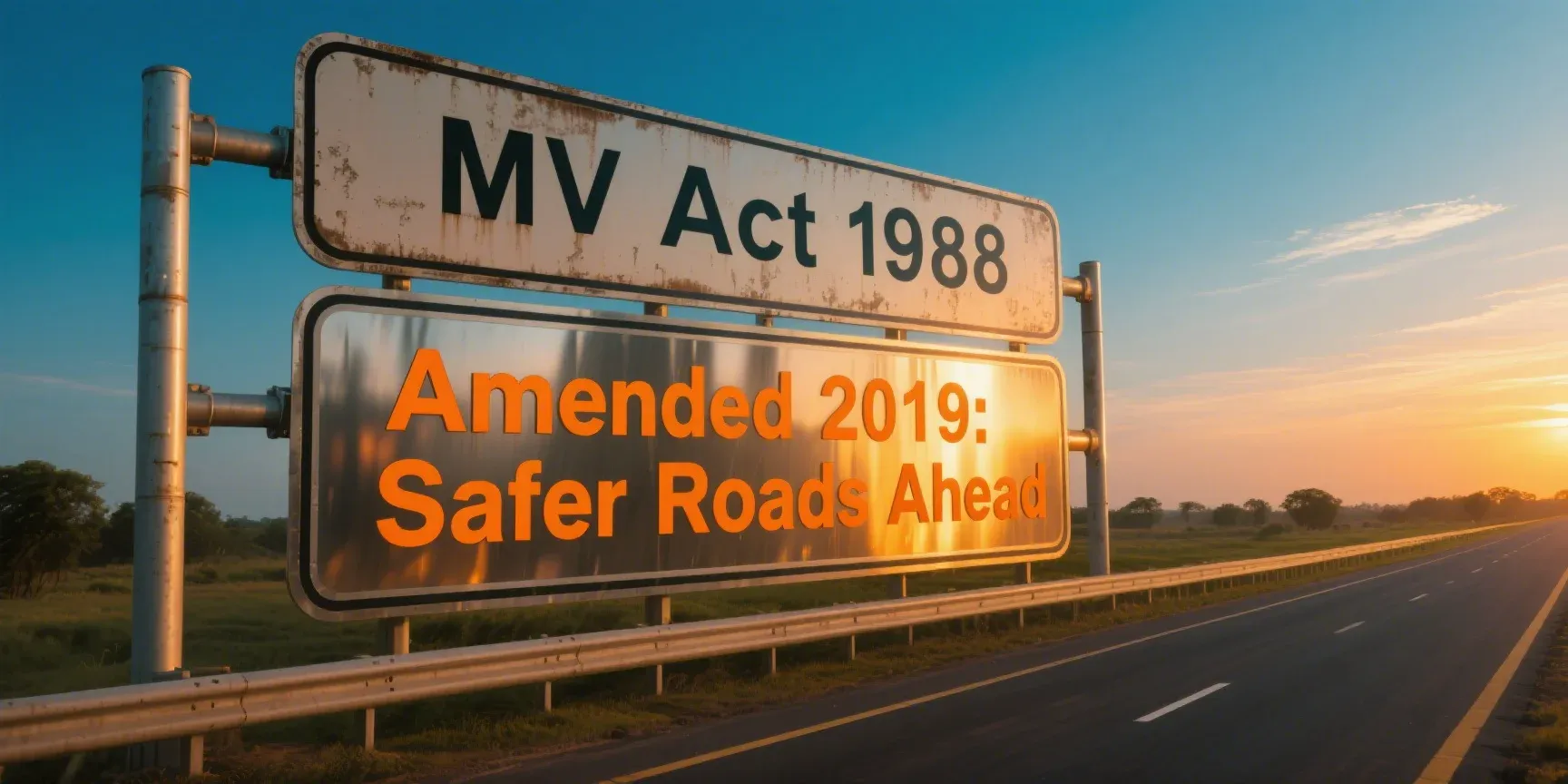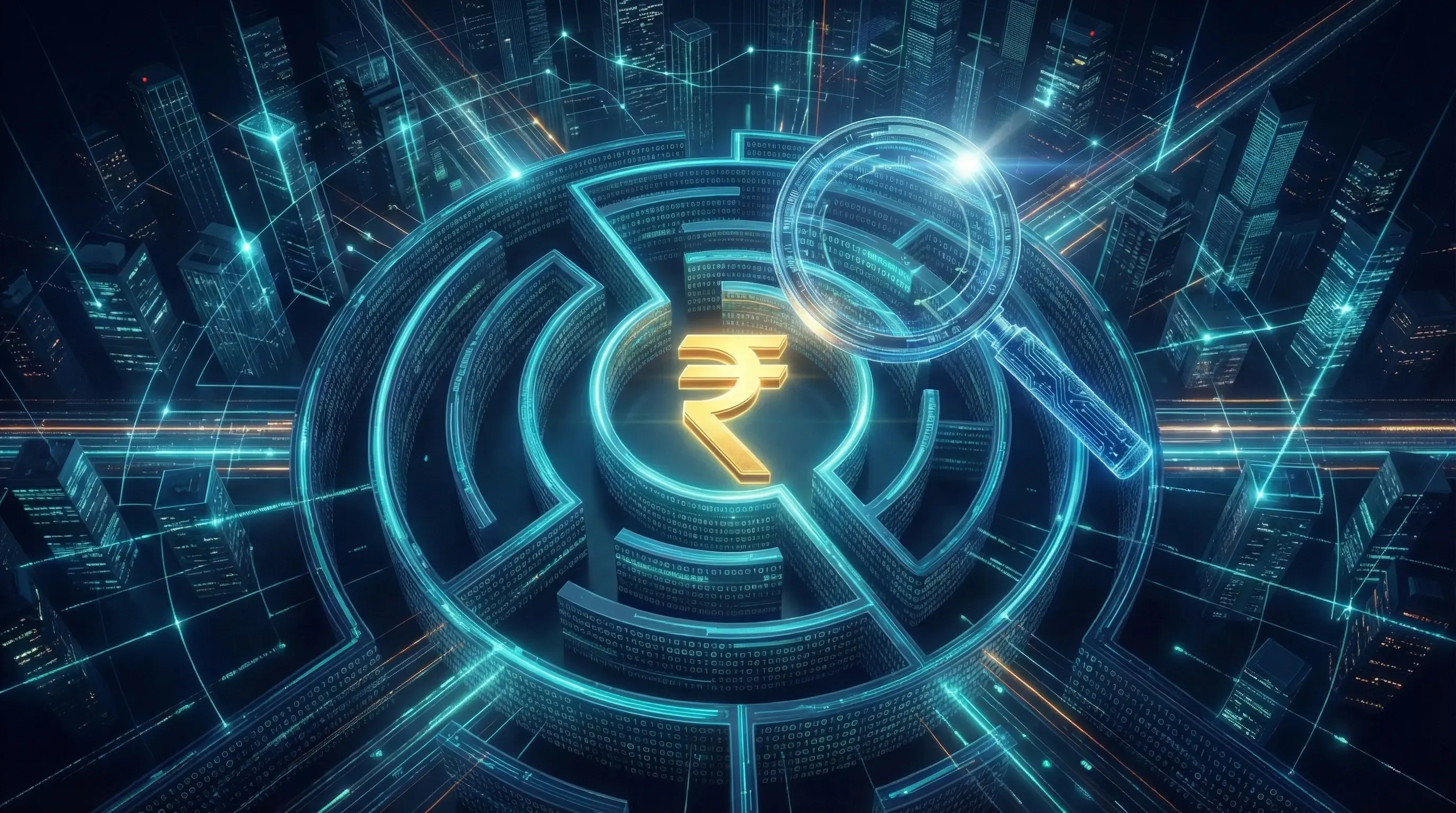
The Motor Vehicles Act: A Deep Dive into India's Evolving Road Safety Laws
This comprehensive guide breaks down the Motor Vehicles (Amendment) Act, 2019, detailing the steep new penalties for traffic offenses, crucial changes to road safety laws, and their real-world impact on every driver across India.
The Motor Vehicles Act, 1988 (“MV Act”), the cornerstone of India’s traffic regulation, has undergone a seismic shift with the introduction of the Motor Vehicles (Amendment) Act, 2019. This landmark amendment was not merely a cosmetic update; it represented a paradigm shift in the nation’s approach to road safety, aiming to curb the alarming rate of traffic fatalities and injuries. By introducing stricter penalties, embracing technology for enforcement, and refining key legal provisions, the 2019 Amendment Act seeks to instill a greater sense of discipline and accountability on Indian roads.
This comprehensive analysis explores the nuances of several pivotal sections of the MV Act, dissecting their original intent, the transformative changes brought by the 2019 amendment, and the crucial role of the judiciary in interpreting and applying these laws. From the validity of driving licenses to the stringent penalties for dangerous and drunken driving, we will navigate the legal landscape that governs every driver and vehicle owner in India.
1. Section 13: The Nationwide Effectiveness of a Driving License
A driving license is the fundamental document that authorizes an individual to operate a motor vehicle. Section 13 of the MV Act establishes a crucial principle for a country as vast and diverse as India.
Core Provision (Pre-2019): The original Section 13 was succinct and clear: a learner’s license or a driving license issued under the Act is effective throughout India. This provision ensures that a license granted by a competent authority in one state is valid and recognized in every other state and union territory, facilitating seamless inter-state travel and a uniform system of licensing.
Motor Vehicle (Amendment) Act, 2019 Changes: While Section 13 itself was not amended, the 2019 Act introduced changes to associated sections, particularly Section 14, which deals with the duration of licenses. These amendments modified the validity periods, especially for transport vehicle licenses, and introduced requirements for refresher training for renewals in certain categories. This indirectly affects the conditions under which a license remains “effective” as stipulated by Section 13.
Judicial Interpretation and Application: The judiciary has often been called upon to interpret the “effectiveness” of a driving license, not just geographically, but also in terms of the class of vehicle it authorizes. A major point of legal debate revolved around whether a Light Motor Vehicle (LMV) license holder could drive a transport or commercial vehicle of the same weight class without a specific endorsement.
The Supreme Court, in the landmark case of Mukund Dewangan v. Oriental Insurance Company Limited (2017), provided a decisive clarification. The Court ruled that a driver with a license for a light motor vehicle is authorized to drive a transport vehicle of that category without needing a separate endorsement. This judgment, which emphasized a beneficial interpretation of the law, resolved conflicting opinions among various High Courts and brought relief to millions of commercial drivers. The Supreme Court recently affirmed that the Mukund Dewangan judgment will continue to apply while a larger bench reconsiders the issue, acknowledging the significant impact a reversal would have on the livelihoods of many drivers.
2. Section 129: The Mandate for Protective Headgear (Helmets)
The helmet law is one of the most visible and critical road safety regulations, directly aimed at reducing the severity of head injuries in two-wheeler accidents.
Core Provision (Pre-2019): The earlier Section 129 mandated that every person driving or riding a motorcycle (except in a sidecar) in a public place must wear a helmet that conforms to the standards of the Bureau of Indian Standards (BIS). An exemption was provided for Sikhs wearing turbans.
Motor Vehicle (Amendment) Act, 2019 Changes: The 2019 Amendment Act replaced the old Section 129 with a more comprehensive provision. The key changes include:
- Expanded Scope: The rule now explicitly applies to “every person, above four years of age, driving or riding or being carried on a motorcycle.”
- Safety of Children: It empowers the Central Government to formulate rules for the safety of children below the age of four on motorcycles.
- Stringent Penalty: Violation of the helmet rule is now punishable under the new Section 194D, which imposes a fine of one thousand rupees and a three-month disqualification of the driving license.
Judicial Interpretation and Application: While the mandatory nature of wearing a helmet is undisputed, a significant legal question arises in accident compensation claims: does not wearing a helmet amount to “contributory negligence”? This would mean the victim contributed to their own injury, potentially reducing the compensation amount.
The judiciary has largely adopted a victim-centric approach. Courts have consistently held that the non-wearing of a helmet, while a punishable offense, does not automatically prove contributory negligence. To reduce compensation, the insurance company must establish a direct causal link between the absence of a helmet and the cause of the accident or the severity of the injury.
In cases like National Insurance Co. Ltd. v. Kadeeja Musliyar, the courts have ruled that violating Section 129 is not, by itself, a ground for assuming contributory negligence. The Supreme Court in Mohammed Siddique v. National Insurance Company Ltd. (2020) reinforced this principle, stating that a violation of law does not amount to contributory negligence unless it is proven that the violation contributed to the accident or its impact. However, some High Court judgments have occasionally upheld a minor deduction (e.g., 10%) for contributory negligence if the head injury was directly attributable to the absence of a helmet. The prevailing judicial view is that a clear causal connection must be proven.
3. Section 166: Securing Just Compensation for Accident Victims
Section 166 is a cornerstone of motor vehicle law, providing a legal pathway for victims of road accidents or their families to seek financial redress.
Core Provision (Pre-2019): This section laid out the procedure for filing a compensation claim, specifying who can file a claim (the injured person, property owner, or legal representatives of the deceased) and the jurisdiction of the Motor Accidents Claims Tribunal (MACT). A claim could be filed where the accident occurred, where the claimant resides, or where the defendant resides.
Motor Vehicle (Amendment) Act, 2019 Changes: The 2019 amendment introduced significant changes to streamline the claims process:
- Lapsing of Claim: A new proviso was added, stating that if a person accepts the no-fault liability compensation under Section 164, their claim petition before the MACT will lapse.
- Survival of Claim: A new sub-section (5) was inserted, clarifying that the right to claim compensation survives to the legal representatives even if the injured person dies, irrespective of whether the death was caused by the accident-related injuries. This nullifies the old common law maxim actio personalis moritur cum persona (a personal right of action dies with the person) in motor accident cases.
Judicial Interpretation and Application: The judiciary’s interpretation of Section 166 has been guided by the principle of ensuring “just compensation” for victims.
- Jurisdiction: Courts have adopted a liberal interpretation of the MACT’s territorial jurisdiction. The Supreme Court, in cases like Malati Sardar v. National Insurance Company Limited (2016), has held that a claim can be filed even at a place where the insurance company has a branch office, to ease the burden on claimants.
- Just Compensation: Tribunals are not strictly bound by the amount claimed in the petition. Courts have repeatedly affirmed that the MACT has a statutory duty to award what it deems to be “just compensation” based on the evidence, which can exceed the amount initially sought by the claimant.
- Procedure: A claim is initiated by filing an application with the MACT, supported by evidence like the police First Information Report (FIR), medical reports, and proof of income. While there is no strict time limit for filing a claim, it is advisable to do so promptly.
4. Section 177: The General Penalty for Miscellaneous Offences
Section 177 acts as a catch-all provision, prescribing penalties for violations of the MV Act for which no specific punishment is mentioned elsewhere.
Core Provision (Pre-2019): Before the amendment, this section imposed a modest fine of up to one hundred rupees for a first offense and up to three hundred rupees for a subsequent offense.
Motor Vehicle (Amendment) Act, 2019 Changes: Recognizing that the previous penalties were not a significant deterrent, the 2019 Act substantially increased the fines under Section 177.
- First Offense: The fine has been increased to five hundred rupees.
- Subsequent Offense: The fine for a second or subsequent offense is now one thousand five hundred rupees.
- Section 177A: A new section was also introduced to penalize the violation of driving regulations made under Section 118, with a fine between five hundred and one thousand rupees.
Judicial Interpretation and Application: The steep increase in these general penalties reflects the legislative intent to enforce greater compliance with all traffic rules, however minor they may seem. These increased fines are part of a broader strategy to improve road safety by making every violation a more costly affair for the offender.
5. Section 180: The Owner’s Responsibility for Unauthorized Driving
This section places a crucial responsibility on the vehicle owner, holding them accountable for who they allow to drive their vehicle.
Core Provision (Pre-2019): Section 180 penalized the owner or person in charge of a vehicle for causing or permitting it to be driven by someone without a valid license (as required by Section 3) or who is underage (as per Section 4). The punishment was imprisonment for up to three months, a fine of up to one thousand rupees, or both.
Motor Vehicle (Amendment) Act, 2019 Changes: The 2019 amendment kept the term of imprisonment the same but significantly enhanced the monetary penalty.
- Increased Fine: The fine was increased five-fold from “one thousand rupees” to “five thousand rupees”.
Judicial Interpretation and Application: The core principle underpinning this section is the owner’s vicarious liability. Courts have consistently emphasized that owners have a duty to ensure that any person they permit to drive their vehicle is legally authorized to do so.
However, the interpretation is not absolute. Mere registered ownership is not always sufficient to attract liability. In cases where an owner has sold the vehicle and no longer has control over it, courts have quashed proceedings under Section 180, even if the registration transfer was not complete. The key element is whether the owner “caused or permitted” the unauthorized use. The enhanced penalty of Rs. 5,000 serves as a much stronger deterrent, compelling owners to be more diligent.
6. Section 184: Cracking Down on Dangerous Driving
Section 184 is one of the most critical penal provisions in the Act, directly targeting reckless behavior that endangers public safety.
Core Provision (Pre-2019): The original section penalized driving at a speed or in a manner that is “dangerous to the public,” considering the specific circumstances of the location and traffic. The penalty was imprisonment up to six months or a fine up to one thousand rupees for the first offense.
Motor Vehicle (Amendment) Act, 2019 Changes: The 2019 amendment dramatically broadened the scope and severity of this section, making it a powerful tool for law enforcement.
- Expanded Definition: The definition of “dangerous driving” now includes acts that cause “a sense of alarm or distress” to others on the road.
- Specific Offences: An explanation was added, explicitly listing several actions as dangerous driving:
- Jumping a red light
- Violating a stop sign
- Using handheld communication devices while driving
- Improper overtaking
- Driving against the flow of traffic
- Harsher Penalties: The penalties have been significantly increased.
- First Offense: Imprisonment for six months to one year, or a fine between one thousand and five thousand rupees, or both.
- Subsequent Offense: Imprisonment for up to two years and a fine of up to ten thousand rupees.
Judicial Interpretation and Application: The amendments to Section 184 provide much-needed clarity. By defining specific acts as dangerous driving, the law reduces ambiguity and makes it easier to prosecute offenders. The inclusion of using mobile phones, for example, directly addresses a modern-day menace that contributes to countless accidents. The substantially higher fines and mandatory minimum imprisonment for a first offense signal a zero-tolerance policy towards behavior that puts lives at risk.
7. Section 185: The Zero-Tolerance Stance on Drunken Driving
Driving under the influence of alcohol or drugs is a grave offense with devastating consequences. Section 185 provides the legal framework for penalizing such irresponsible acts.
Core Provision (Pre-2019): This section penalized driving with a Blood Alcohol Concentration (BAC) exceeding 30 mg per 100 ml of blood, as detected by a breathalyzer, or being under the influence of a drug to an extent that renders the driver incapable of proper control. The penalty for a first offense was imprisonment for up to six months or a fine up to two thousand rupees.
Motor Vehicle (Amendment) Act, 2019 Changes: The 2019 Act strengthened this section to close loopholes and increase deterrence.
- Expanded Testing Methods: The law now permits the use of “any other test including a laboratory test” in addition to a breathalyzer to confirm intoxication.
- Stricter Penalties for Repeat Offenders: The three-year time limit for considering a subsequent offense was removed. Now, any repeat offense, regardless of when it occurred, will attract a higher penalty.
- Massive Fine Hike: The fines were increased substantially:
- First Offense: The fine was increased from two thousand rupees to ten thousand rupees.
- Subsequent Offense: The fine was increased from three thousand rupees to fifteen thousand rupees.
Judicial Interpretation and Application: The judiciary strictly enforces the procedural requirements for a conviction under Section 185.
- Proof of Intoxication: For a conviction, the prosecution must prove through a permissible test (breathalyzer or lab test) that the BAC level exceeded the legal limit of 30 mg per 100 ml of blood. The mere smell of alcohol or a doctor’s certificate stating the person was intoxicated, without a quantified BAC report, is generally considered insufficient for a conviction under this specific section.
- Insurance Claims: In a significant ruling in Iffco Tokio General Insurance Company Ltd. v. Pearl Beverages Ltd. (2021), the Supreme Court clarified that while a criminal conviction under Section 185 requires a specific BAC level from a prescribed test, an insurance company can still repudiate a claim by proving “driving under the influence” through other circumstantial evidence, especially if the driver absconds and prevents a test from being conducted.
The 2019 amendments have made the financial consequences of drunk driving far more severe, aiming to create a powerful deterrent against this life-threatening behavior.
Conclusion: A New Era of Road Safety and Accountability
The Motor Vehicles (Amendment) Act, 2019, is a watershed moment in India’s journey towards safer roads. By sharpening the definitions of offenses, embracing technology, and, most notably, imposing penalties that are genuinely deterrent, the law reflects a clear legislative resolve to protect human life.
The judiciary, through its interpretations, continues to play a vital role in ensuring these laws are implemented effectively and justly. By balancing the technical requirements of the law with its overarching beneficial objectives, courts ensure that the rights of victims are protected while holding offenders accountable. This dynamic interplay between robust legislation and considered judicial oversight is paving the way for a new era of road safety culture in India, where the cost of non-compliance is high, and the value of a human life is held paramount.
Frequently Asked Questions (FAQ)
Q1: What was the main objective of the Motor Vehicles (Amendment) Act, 2019? The primary objective was to enhance road safety, reduce traffic accidents and fatalities, strengthen traffic discipline through stricter penalties, streamline processes using technology, and improve provisions for compensating accident victims.
Q2: What is the current fine for not wearing a helmet in India? Under the amended Section 129 and the new Section 194D of the Motor Vehicle Act, the penalty for not wearing a helmet is a fine of Rs. 1,000 and disqualification of the driving license for three months.
Q3: Can I drive a small commercial taxi with my private car (LMV) license? Yes. According to the Supreme Court’s judgment in Mukund Dewangan v. Oriental Insurance Company Limited (2017), a person holding a license for a ‘light motor vehicle’ (LMV) can drive a transport vehicle of the LMV class (unladen weight less than 7500 kgs) without a separate commercial endorsement.
Q4: What are the specific actions now considered “dangerous driving” under Section 184? The 2019 amendment to Section 184 explicitly lists several offenses as dangerous driving, including jumping a red light, violating a stop sign, using a handheld mobile phone while driving, improper overtaking, and driving against the flow of traffic.
Q5: What is the penalty for dangerous driving for the first time? For a first offense of dangerous driving under Section 184, the penalty is imprisonment for a term between six months and one year, or a fine between Rs. 1,000 and Rs. 5,000, or both.
Q6: What is the legal alcohol limit for driving in India as per Section 185? The legal limit is a Blood Alcohol Concentration (BAC) of not more than 30 mg of alcohol per 100 ml of blood.
Q7: What is the fine for drunk driving for a first-time offender? The fine for a first-time drunk driving offense under Section 185 has been increased to Rs. 10,000, or imprisonment for up to six months, or both.
Q8: What is the general penalty under Section 177 for an offense with no specific fine? For offenses where no specific penalty is provided in the Act, Section 177 now prescribes a fine of Rs. 500 for the first offense and Rs. 1,500 for any subsequent offense.
Q9: I am the owner of a car. What is my liability if my friend drives it without a license and is caught? Under Section 180, as the owner, you can be held liable for permitting an unauthorized person to drive your vehicle. The penalty is a fine of Rs. 5,000, imprisonment for up to three months, or both.
Q10: Can I file a motor accident compensation claim in the city I live in, even if the accident occurred in another state? Yes. Section 166 of the MV Act allows you to file a claim with the Motor Accidents Claims Tribunal (MACT) that has jurisdiction over the area where you reside or carry on business, where the defendant (vehicle owner/driver) resides, or where the accident occurred. The Supreme Court has encouraged a liberal approach to facilitate claims for victims.


